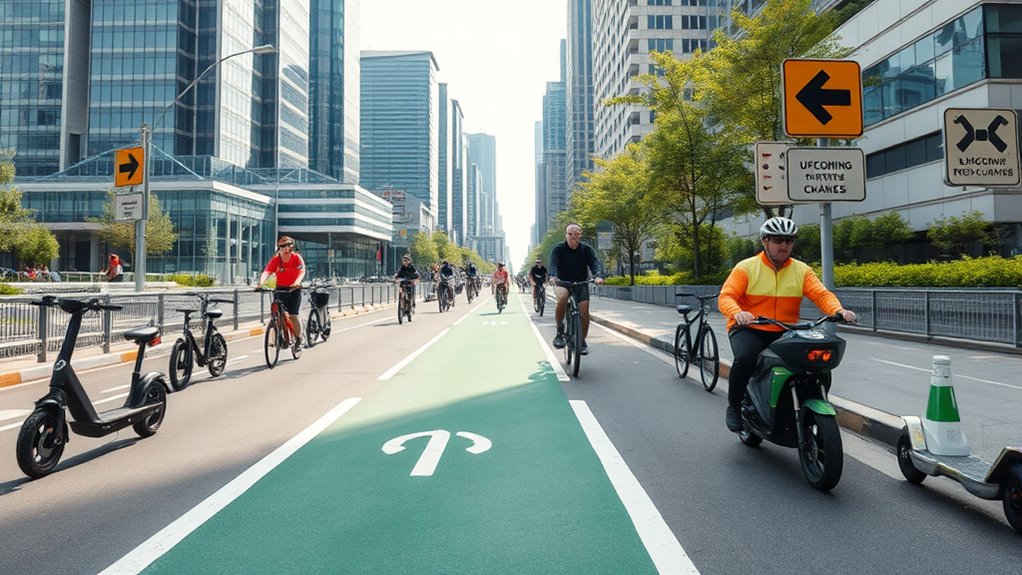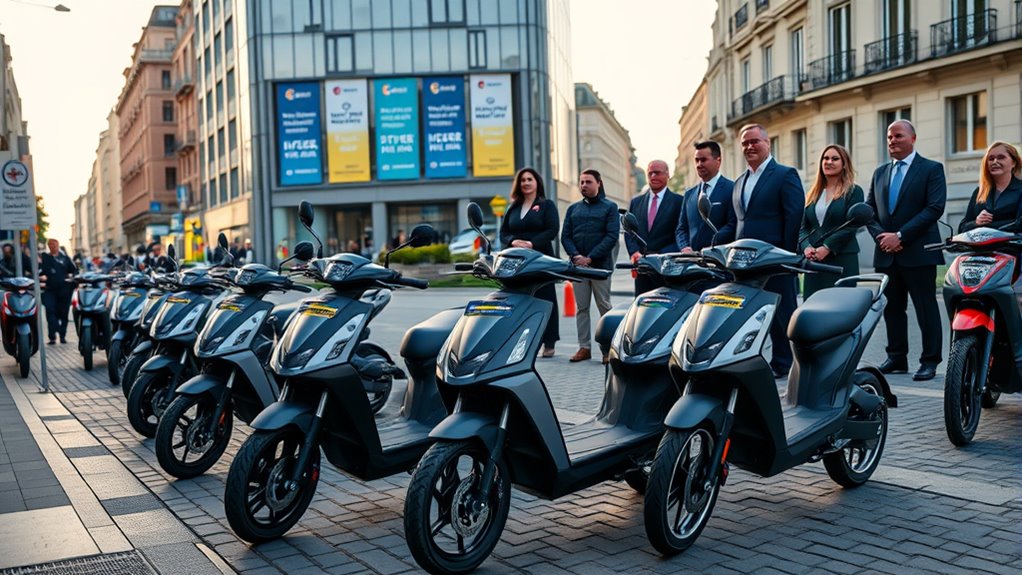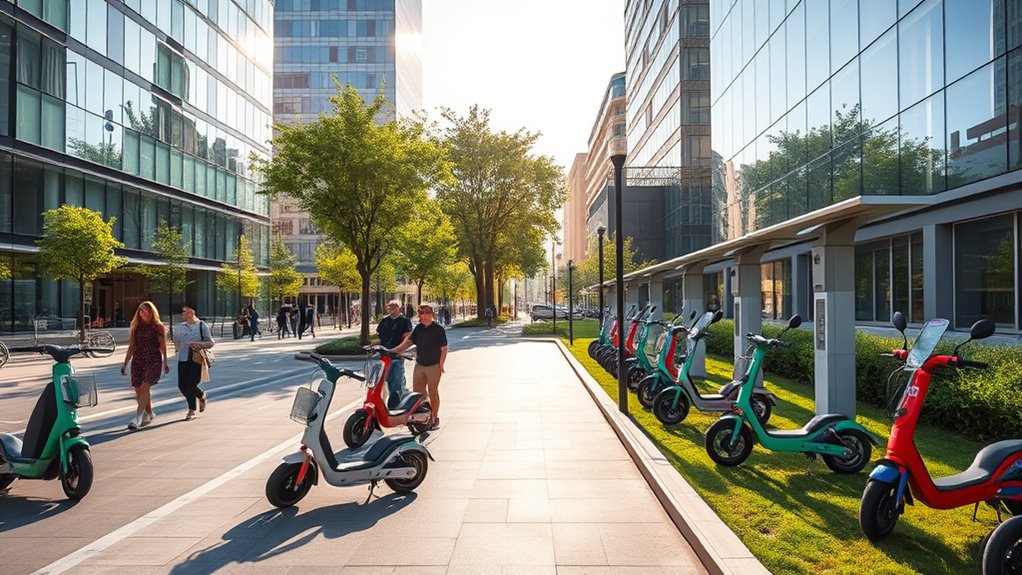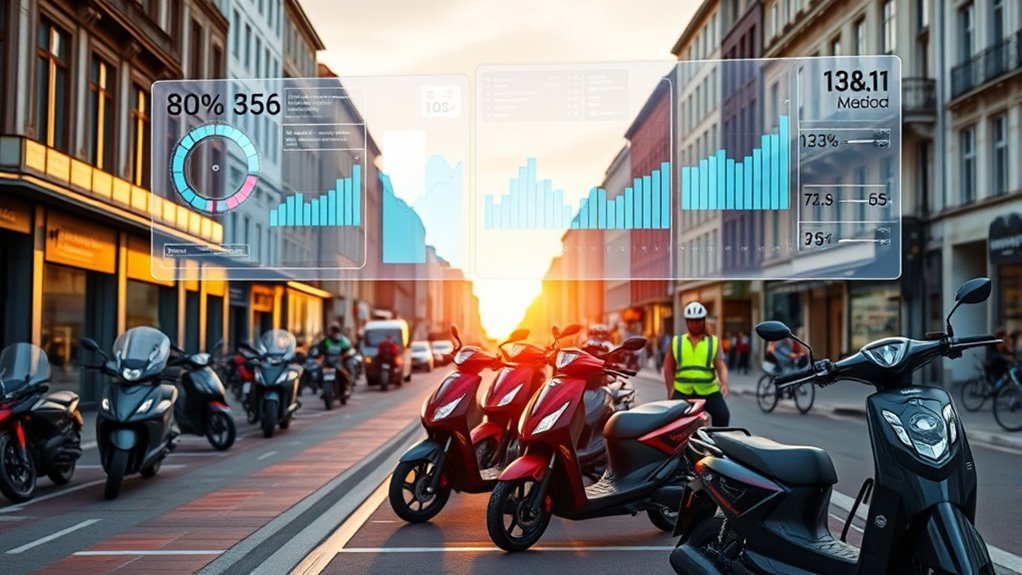Upcoming micro-mobility policy changes in Europe focus on strengthening safety standards, requiring licenses and registration for operators, and promoting safer device designs. Authorities are designating parking zones and setting speed and usage limits to better regulate public spaces. Environmental sustainability is also a priority, with initiatives encouraging eco-friendly practices and improved data sharing. These reforms aim to make urban micro-mobility safer, greener, and more organized—stay tuned to discover all the details shaping Europe’s mobility future.
Key Takeaways
- Europe is implementing stricter safety standards, including device design, licensing, and user education programs.
- New policies will standardize micro-mobility insurance regulations across countries for better cross-border protection.
- Urban infrastructure plans focus on designated parking zones, real-time monitoring, and optimized urban zoning.
- Speed limits, usage restrictions, and designated zones aim to improve safety and pedestrian integration.
- Emphasis on eco-friendly practices involves promoting recyclable materials, sustainable battery technology, and reducing carbon footprints.
Strengthening Safety Regulations for Micro-Mobility Devices

As Europe moves toward stricter micro-mobility policies, safety regulations for devices like e-scooters and e-bikes become more critical. Ensuring rider safety involves not only enforcing standards but also promoting micro mobility insurance, so you’re protected in case of accidents. Proper insurance coverage helps cover damages and injuries, giving you peace of mind. Equally important is user education; understanding how to operate your device safely reduces risks. Authorities are emphasizing training programs and clear guidelines to inform riders about safe practices. By combining these measures, Europe aims to create a safer environment for everyone. Strengthening safety regulations guarantees that as micro-mobility grows, rider protection remains a top priority, making these devices safer and more reliable for daily use. Additionally, incorporating safe device design standards can help minimize accidents and improve overall safety.
Implementing Licensing and Registration Requirements for Operators

As Europe introduces licensing and registration rules for micro-mobility operators, you’ll need to understand the application processes involved. Ensuring compliance with registration standards will be vital for staying authorized to operate. Let’s explore how these requirements aim to improve accountability and safety across the industry. Proper storage and handling of equipment can also play a role in maintaining safety standards.
Licensing Application Processes
How will European authorities streamline licensing and registration processes for micro-mobility operators? They aim to simplify application procedures by establishing clear, unified requirements across regions. Operators will need to submit documentation demonstrating compliance with safety standards, including micro mobility insurance, to cover potential liabilities. The process will involve streamlined online platforms for submitting applications, reducing delays. Authorities may also require evidence of user training programs to ensure rider safety and awareness. Additionally, incorporating nutrient-rich components into safety protocols can enhance overall service quality. By standardizing these steps, authorities intend to make it easier for operators to obtain licenses, encouraging compliance and innovation. This approach minimizes bureaucratic hurdles and promotes a more efficient, transparent licensing system, ultimately supporting safer, better-regulated micro-mobility services across Europe.
Registration Compliance Standards
Streamlining licensing processes naturally leads to establishing clear registration compliance standards for micro-mobility operators. To ensure safety and accountability, authorities will focus on three key areas:
- Micro mobility insurance requirements, making sure operators carry adequate coverage to protect users and third parties.
- Implementing user behavior analytics tools to monitor riding patterns, identify high-risk behaviors, and improve safety standards.
- Enforcing strict registration protocols that verify operator legitimacy and compliance with local regulations.
These standards will help authorities track operator performance, reduce accidents, and promote responsible usage. By emphasizing transparent registration processes, you’ll help create a safer, more reliable micro-mobility ecosystem that balances innovation with public safety.
Designating and Optimizing Parking Zones in Urban Areas

You need to focus on placing parking zones thoughtfully to serve high-demand areas effectively. Managing these zones efficiently guarantees micro-mobility devices are accessible and reduce clutter. Prioritizing strategic placement and smart management can substantially improve urban mobility. Additionally, considering cost and budgeting factors for infrastructure development can ensure the long-term sustainability of these parking solutions.
Strategic Zone Placement
Effective strategic zone placement is essential for maximizing the efficiency and safety of micro-mobility systems in urban areas. Proper urban zoning ensures designated areas suit rider behavior and city infrastructure. To achieve this, you should focus on:
- Analyzing high-traffic corridors to identify suitable parking and riding zones.
- Engaging stakeholders—including city officials, residents, and business owners—to gather diverse insights.
- Balancing accessibility with congestion reduction by designing zones that promote safe, convenient access. Utilize vertical storage solutions to optimize space in urban zones and reduce clutter.
Efficient Parking Management
Designating and optimizing parking zones is essential for the success of micro-mobility systems in cities. Effective urban zoning and smart parking solutions reduce congestion and improve user experience. By clearly defining zones for scooters and bikes, you can prevent clutter and ensure availability. Smart parking systems help monitor space utilization and guide users to nearest parking spots, increasing efficiency. Use the following table to understand key benefits:
| Benefit | Description | Impact |
|---|---|---|
| Reduced congestion | Proper zoning minimizes illegal or random parking | Faster rides, less clutter |
| User convenience | Easy access to designated parking zones | Increased system adoption |
| Better management | Real-time data for optimizing parking areas | Cost-effective operations |
| Urban zoning | Clear boundaries for different vehicle types | Improved city planning |
| Enhanced safety | Less haphazard parking reduces accidents | Safer streets |
Implementing effective wall organization in urban planning can also contribute to creating organized and visually appealing micro-mobility hubs.
Setting Speed Limits and Usage Restrictions in Public Spaces

How will new speed limits and usage restrictions shape the way micro-mobility devices are integrated into European public spaces? These policies aim to enhance safety and harmony by implementing:
- Clear speed regulation to prevent accidents and ensure predictable movement.
- Defined zones where devices can be used, reducing conflicts with pedestrians.
- Mandatory user education programs to promote responsible riding.
- Awareness of regional and local bank hours can assist users in planning their transportation needs around banking services.
Promoting Environmental Sustainability and Eco-Friendly Practices

Building on efforts to regulate speed and usage, promoting environmental sustainability in micro-mobility practices can considerably reduce urban pollution and carbon emissions. Advances in battery technology enable e-scooters and bikes to last longer and charge faster, minimizing waste and energy consumption. Supporting eco-friendly practices also involves improving urban infrastructure, such as dedicated lanes and charging stations, to encourage cleaner transportation options. By investing in sustainable battery solutions and integrating these into city planning, you help lower the carbon footprint of micro-mobility services. This shift not only promotes cleaner air but also fosters healthier urban environments. Emphasizing eco-conscious choices ensures that micro-mobility remains a sustainable, efficient alternative to traditional transport methods while aligning with Europe’s environmental goals. Additionally, utilizing recyclable and biodegradable materials in manufacturing can further enhance the environmental benefits of micro-mobility devices.
Enhancing Data Sharing and Monitoring Systems

To effectively manage micro-mobility systems across Europe, authorities must prioritize enhancing data sharing and monitoring infrastructure. This involves leveraging data anonymization to protect user privacy while ensuring valuable insights are accessible. Real-time analytics enable immediate response to issues like congestion or safety concerns. Key steps include:
- Developing secure platforms for seamless data exchange between cities and providers.
- Integrating advanced monitoring tools that utilize real-time analytics for swift decision-making.
- Ensuring data privacy through robust anonymization techniques, fostering public trust. Additionally, adopting effective communication strategies can improve stakeholder collaboration and public awareness regarding system updates and safety measures.
Aligning Policies Across European Union Member States

Achieving a cohesive micro-mobility framework across European Union member states requires aligning policies to guarantee consistency, safety, and efficiency. You need standardized regulations for micro mobility insurance to assure riders are protected and liabilities are clear across borders. Uniform safety standards help prevent accidents and build trust among users and authorities. Equally important is prioritizing user education, so riders understand local rules, safe riding practices, and responsible behavior. Incorporating safety standards into the policy framework ensures a uniform approach to risk management and accident prevention. By harmonizing these policies, you create a seamless experience for micro-mobility users, reduce confusion, and promote wider adoption. Collaboration among member states is essential to develop all-encompassing regulations that address safety, insurance, and user awareness, fostering a safer, more reliable micro-mobility environment throughout Europe.
Frequently Asked Questions
How Will Policy Changes Impact Micro-Mobility Affordability for Users?
You might find that policy changes affect micro-mobility affordability through new pricing models and user subsidies. As regulations evolve, companies could adjust prices or introduce subsidies to keep services accessible. This means you could see more affordable options or, conversely, higher costs depending on how policies shape pricing strategies. Staying informed helps you understand how these changes could impact your ability to access micro-mobility services affordably.
What Penalties Will Be Enforced for Non-Compliance With New Regulations?
Oh, the thrill of breaking rules! You’ll find that penalties enforcement is no joke—authorities are serious about cracking down. Expect strict fine structures that make every misstep costly, from hefty fines for minor infractions to larger penalties for repeat offenders. So, if you’re thinking about bending the rules, remember that enforcement is tight, and the fines are designed to keep you in line. Better to stay compliant and avoid the cash drain!
How Will Policies Address Accessibility for Disabled Micro-Mobility Users?
You’ll find that policies aim to remove accessibility barriers by emphasizing inclusive design in micro-mobility options. They require manufacturers and providers to guarantee devices are usable by disabled users, promoting features like adjustable controls and tactile indicators. These measures help create a more equitable transportation environment, allowing everyone to access and benefit from micro-mobility services. The focus is on removing barriers and fostering inclusivity for all users.
Are There Plans to Incorporate Emerging Technologies Like AI in Regulation Enforcement?
You might wonder if emerging technologies like AI will be part of regulation enforcement. Authorities are exploring AI integration to monitor micro-mobility usage more efficiently, but they must balance this with data privacy concerns. While AI can help enforce rules and improve safety, you should stay informed about how your data is used and protected, ensuring technology benefits everyone without compromising your privacy.
How Will Policies Support Innovation and Growth in the Micro-Mobility Sector?
Think of policies as the bridges connecting micro-mobility to city life. They’ll support innovation by encouraging urban integration and infrastructure development, making it easier for you to use e-scooters and e-bikes seamlessly. Clear regulations will foster growth, ensuring safety and sustainability. By investing in smart infrastructure and streamlining rules, policies will turn micro-mobility into a essential part of urban transport, helping you move efficiently and eco-friendly through your city.
Conclusion
As Europe’s micro-mobility policies take shape, you’re standing at the crossroads of innovation and regulation. These changes are the compass guiding safer, more sustainable urban journeys, like a lighthouse illuminating the path forward. By embracing these updates, you’ll help shape cities where mobility flows seamlessly, harmonizing progress with safety. Together, these policies form the threads weaving a resilient, eco-friendly tapestry—ensuring your ride into the future is smoother and smarter than ever.









